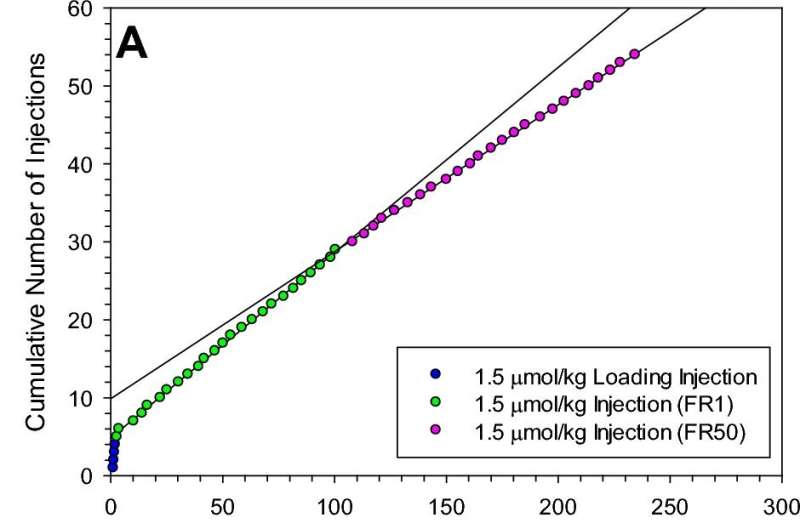This article has been reviewed according to Science X's editorial process and policies. Editors have highlighted the following attributes while ensuring the content's credibility:
fact-checked
peer-reviewed publication
trusted source
proofread
Research challenges traditional theory of mechanisms of cocaine self-administration

For more than 50 years, the conventional wisdom in the field of research in cocaine use has been that people take cocaine based on the theory of the drug providing positive reinforcement to the user.
New research out of the University of Cincinnati shows that a pharmacological equation disproves that concept and could spark a major shift in that field of research. The study was published in the journal Scientific Reports.
Andrew Norman, Ph.D., professor in the Department of Pharmacology and Systems Physiology at the UC College of Medicine and corresponding author of the study, says that in 1968, the first paper on cocaine self-administration was published showing that it was an example of operant behavior theory, a method of learning that uses rewards and punishment to modify behavior. It suggests that certain things like food or drugs motivate the behavior according to schedules of reinforcement.
"The theory maintains that the more reinforcing a drug is, the faster users take it," Norman says. "Interestingly, animals that self-administer cocaine slow down intake as doses get higher, implying that higher doses are less reinforcing, which doesn't make sense. But at really lower unit doses, the actual number of presses the animal does goes up as you increase the dose."
It was believed, Norman says, that this means that low cocaine doses produce positive reinforcing effects, but high doses produce more rate-limiting effects, so low doses were believed to provide more useful information. He says his research shows that this is not correct.
"We came along in 1998 and formulated this pharmacological-based theory that explained injection intervals, or the time between injections of cocaine," says Norman.
Norman took a different approach by developing an equation that can be measured quantitatively, and it accurately describes the behavior. He says there is none of the elements of "reinforcement" or "wanting" or "liking" that is the basis of the traditional research approach to cocaine self-administration. The study was published in 1999 in Brain Research.
Norman says the recently published research was led by two students working in his lab, Jhanvi Desai and Luis Tron Esqueda, who suggested they conduct a new experiment building on an explanation of cocaine self-administration that Norman had published in 2001.
Desai and Tron Esqueda revived the research in 2022 after talking with Norman and expressing a desire to design an experiment to test Norman's original idea.
"When Dr. Norman was discussing his background, he was explaining to us his previous idea, it was more of an experimental design, and we asked him if he had tested that," Tron Esqueda says. When Norman said he had not tested that, Tron Esqueda and Desai saw an opportunity.
"When Dr. Norman had initially explained to us the paradigm, it was very clear," Desai says. "We predicted what the data should look like, and when we did the experiments and analyzed the data, we found exactly what we were expecting. The only surprising thing was that it was so obvious to us, so I can't understand why other researchers don't see it the way we do."
A subsequent study Desai conducted, which just got published, shows another phenomenon. When access to cocaine is terminated, rats continue lever pressing for a while. Still, after the number of presses to get a dose was increased, there was a considerable increase in the rate of lever pressing for no cocaine, which had never been recognized before.
"The students were right. It was important to do it," Norman says. "The surprising finding was the huge increase in lever pressing behavior when the animals go on these high schedules of lever pressing, which we'd never used before, so I'd never seen that. I believe that is why the field was misled for more than 50 years. They interpreted this as the reinforcing effects of cocaine. Jhanvi's paper shows that it's the schedule, not the cocaine, that does the 'reinforcing." It's been misinterpreted all those decades."
"As pharmacologists, we know that drug effects are related to concentration," adds Norman. "The first question a pharmacologist asks is what is the response that is being induced by this drug. In our case, it's the lever-pressing behavior. Our big innovation with this latest research is that we calculated what the concentration of cocaine is in the body every second of the session. What we show is that there is a range of cocaine concentrations that drive the behavior."
"We are hoping that it will open up everyone else's eyes to what's actually been seen for multiple decades now," Tron Esqueda says. "It will hopefully start shifting the current idea on how to study cocaine addiction into a newer idea."
"I think it's going to be a paradigm shift of how to approach preclinical cocaine self-administration studies in animal models," Desai says. "This will hopefully be an example of how to design experiments and interpret data appropriately so that the knowledge can be applied to cocaine use in humans."
More information: Jhanvi N. Desai et al, The ascending limb of the cocaine unit dose–response function in rats as an experimental artifact, Scientific Reports (2023). DOI: 10.1038/s41598-023-43506-y



















